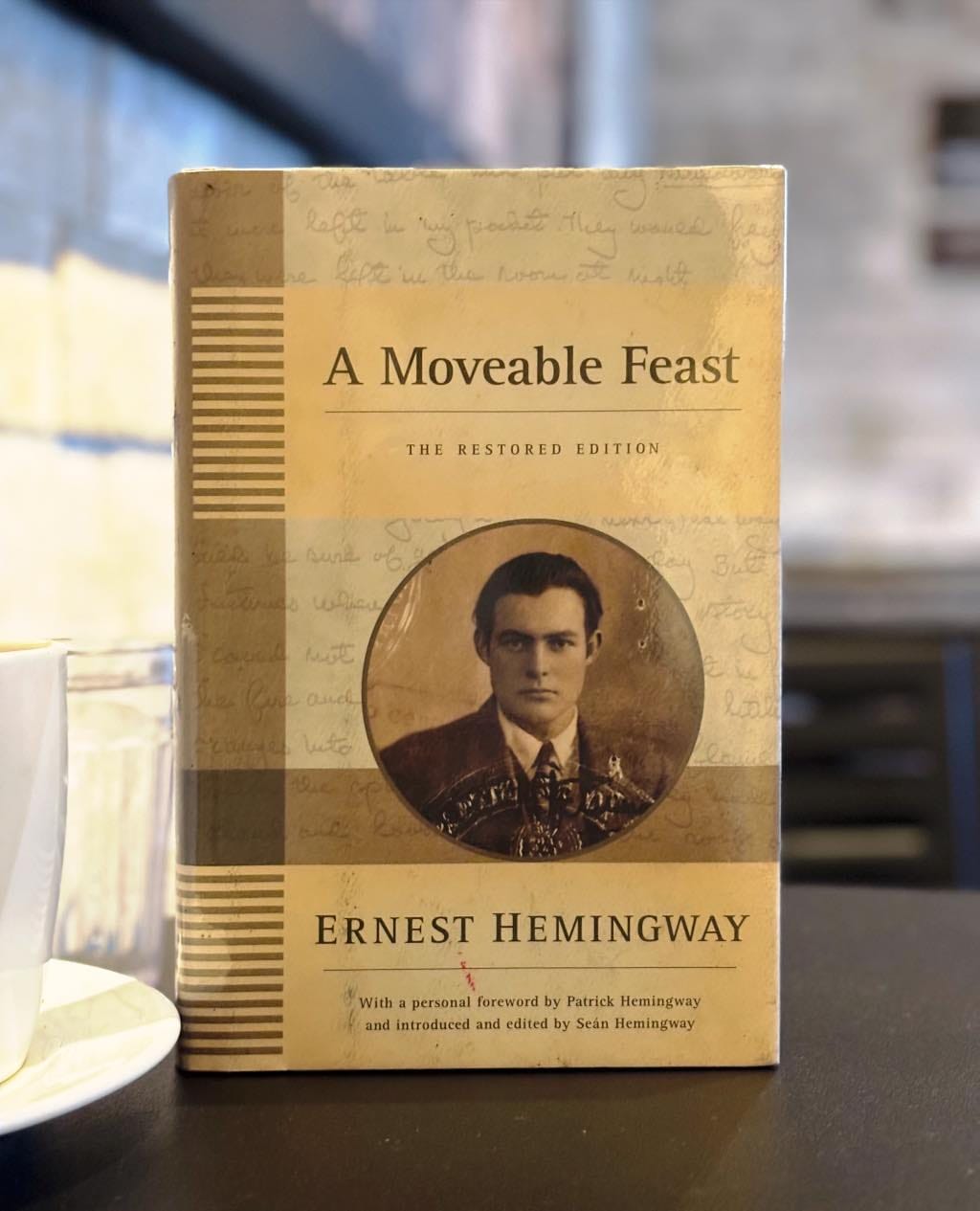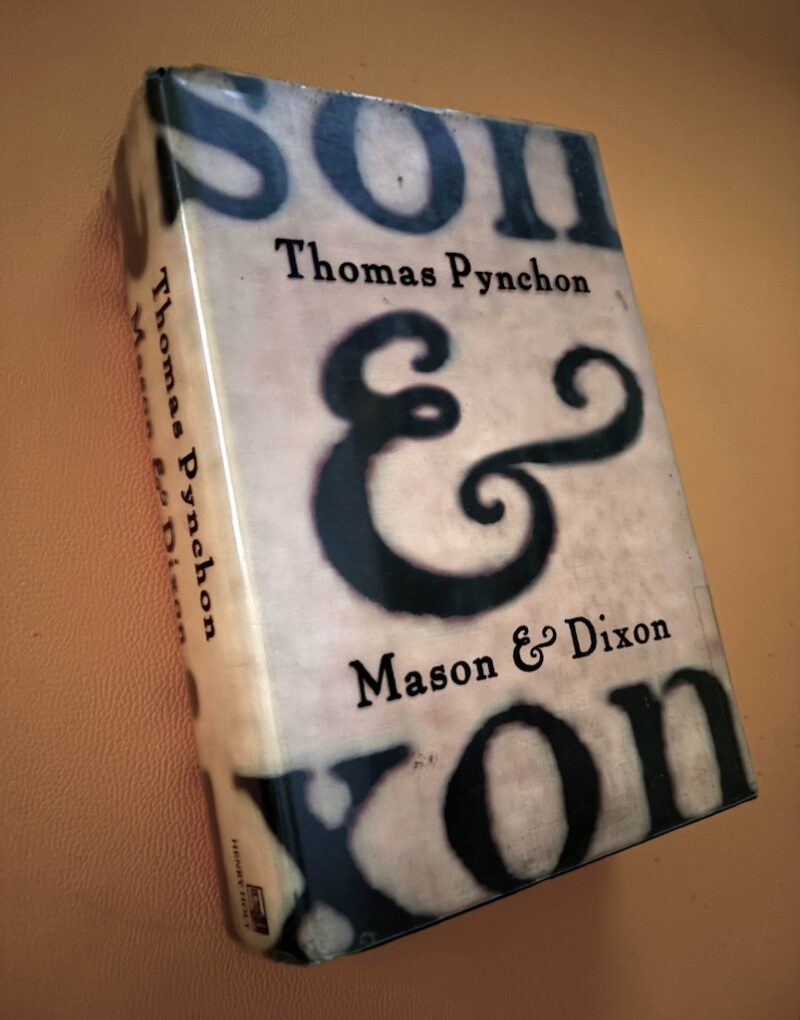Ernest Hemingway’s A Moveable Feast (1964) is often described as a nostalgic homage to Paris in the 1920s, a sentimental recollection of the days when he was a young writer still sharpening his voice. But behind the vignettes and sunlit cafés lies something more purposeful. This isn’t simply a memoir; it’s a final reckoning. Written near the end of his life and published posthumously, it reads like a self-portrait painted in layers. Some sections are tender, others scathing, and many are carefully placed to influence how he’d be remembered.
The book covers Hemingway’s early years in Paris with his first wife, Hadley Richardson, and their child. It’s populated by literary names that have since become cultural bywords: Gertrude Stein, F. Scott Fitzgerald, Ezra Pound. Yet what lingers is not just the glamour of literary expats or the charm of struggling through cold winters on café trips. Hemingway builds something subtler: a vision of himself as both observer and architect of an era. He casts a critical eye on those around him and on the illusions he once held.
Far from a simple remembrance, the work functions as Hemingway’s last attempt to assert authorship over his own life. With the failures of his later years pressing in, he looked back to a time when he was still developing. That revisitation is not pure nostalgia, but one laced with bitterness, control, and the need to arrange the past in a way the present no longer permitted. This tension between memory and invention, warmth and resentment, makes A Moveable Feast Hemingway’s most personal and most constructed work.
The Setting and Time of Writing
When readers turn to A Moveable Feast, they often picture Hemingway at a small Paris café table, notebook in hand, with sunlight slanting over his shoulder. But the truth of its writing lies far from that image. He began assembling the manuscript in the late 1950s, decades after the events it memorializes. The Paris years (1921 to 1926) had passed. The marriages had ended. The friendships had dissolved or faded. The Hemingway of the manuscript was not the man scribbling on a café terrace but one confronting regret, decline, and the failures of his later work.
By the time he began assembling the material, Hemingway was no longer the writer who had transformed modern fiction with The Sun Also Rises (1926) or A Farewell to Arms (1929). The prose recalls youth, but the project alone belongs to old age. It was written in Cuba, Idaho, and Key West. The notebooks he mined had been stored for decades in trunks at the Ritz Hotel in Paris, and were only rediscovered in 1956. By then, Hemingway had already suffered head injuries, lost his creative momentum, and felt increasingly shut out of a literary culture he once dominated.
Memoir Defined by Retrospect
The text often reads as though it had been written close to the events it describes. Its clean, direct sentences and intimate tone suggest immediacy. Yet, the work is a controlled reconstruction. For any A Moveable Feast analysis to carry authority, it must begin with this contradiction: the Hemingway who writes is not the Hemingway being remembered. What he reconstructed was not just a city or a group of people, but a version of himself no longer accessible. The result is a memoir that feels candid but is sharply arranged. As with much of Hemingway’s work, the omissions speak as loudly as what is shown. The Paris of A Moveable Feast becomes a setting for creative hunger and artistic certainty, but it is filtered through a man who had lost both.
Memory, Reconstruction, and Self-Styling
The events in A Moveable Feast may have occurred in the 1920s, but they are presented through a lens polished in the 1950s—Hemingway does not pretend otherwise. The book does not follow a strict timeline, nor does it attempt to cover the whole span of Hemingway’s Paris years. Instead, he selects scenes that serve a particular view of that period. The poverty is noble, the ambition is pure, and the distractions are external.
The book has often been described as nostalgic, but nostalgia does not fully explain its tone. There is affection, yes, but also resentment and revision. Memory becomes a means of sorting. Those who failed or disappointed him—Stein, Ford, Fitzgerald, even himself—are given exacting treatment. Those who are remembered with warmth, such as Hadley Richardson or Sylvia Beach, are presented with a kind of moral clarity that the others lack.
The postwar generation of American expatriates (later labeled “The Lost Generation”) appears frequently in the book, but not always with affection. Stein is dismissive, Ford is pompous, even Fitzgerald, whom Hemingway admired, is presented as fragile and compromised. These are not portraits of friends remembered fondly; they are character studies, assembled with precision but lacking warmth.
This kind of remembering serves a purpose: it clarifies the author’s own image. He describes the group, less to illuminate them than to establish his place among them. That act of placement is central to the book’s design. It is not simply a Hemingway memoir but a rewriting of origin. The early Paris years, marked by cold apartments and borrowed time, become a foundation for the later Hemingway: the public figure who once seemed inseparable from the commonwealth of letters.
The Portrayal of Other Writers
The literary portraits in A Moveable Feast do more than capture the personalities of a bygone circle. They reflect Hemingway’s careful arrangement of allegiance, admiration, and private resentment. The figures of Gertrude Stein, F. Scott Fitzgerald, Ford Madox Ford, and Ezra Pound appear not as fixed characters from a shared past but as refractions of how he wished to see himself when looking back. Their inclusion serves a narrative of distinction. He defined them as much by their flaws as by their virtues, always in relation to what he was becoming.
Gertrude Stein
Among the writers Hemingway remembers, Stein occupies a particularly complex position. She appears early as a figure of influence, someone he visits often and listens to without interruption. He presents her as intellectually forceful, certain in her judgments, and surrounded by the kind of artistic aura that draws younger writers into her orbit. Yet this early deference does not hold. Hemingway grows increasingly skeptical of her proclamations, such as on painting, literature, and generational identity.
When Hemingway recalls the episode in which he finds her shouting at Alice Toklas, he offers no commentary, only observation. That moment alters the tone of her presence in the memoir. Later, when Stein reappears in the context of her now-famous remark about “a lost generation,” Hemingway recounts the line with guarded respect but detaches himself from the moral authority she once carried. Across the book, his treatment of her drifts from deference to subtle repudiation. This distance is defined by measured withdrawal, not open critique.
Ford Madox Ford
Ford appears briefly in A Moveable Feast. The encounter remains memorable for its underlying discomfort. Hemingway sits alone at a café. Ford joins him. He breathes heavily and maintains a posture Hemingway finds strained. Their interaction revolves around Ford’s declaration that “a gentleman will always cut a cad.” Hemingway registers this assertion without comment. He offers no clear agreement or challenge. The conversation remains unresolved. This generates an atmosphere of muted awkwardness. Hemingway’s portrayal here is notably restrained. It offers observation instead of explicit judgment.
A significant textual variation exists between the editions regarding this scene. The 1964 edition includes dialogue where Ford explains his reasoning: the man failed to raise his hat to a lady. The Restored Edition (2009) omits this specific detail. It relies solely on the maxim that a gentleman always cuts a cad. This editorial difference alters the reader’s perception. The 1964 version provides a concrete motive. The Restored text leaves Ford’s indignation vague, and this emphasizes his pomposity rather than the specific social infraction.
Ezra Pound
Pound appears throughout A Moveable Feast—but especially in “Ezra Pound and His Bel Esprit”—as a measured presence of generosity and intellectual companionship. Hemingway records moments of shared labor, such as teaching Pound to box, and thoughtful conversation that underlines a mutual respect. He portrays Pound as a man with deep loyalty, someone who was “always doing things for people,” and who sought to lift colleagues like T. S. Eliot through the Bel Esprit fund for writers. Even when Pound admits to lying out of fatigue, Hemingway includes the confession without moralizing, noting it as one facet of a larger, complex character.
Although Hemingway doesn’t spare Pound from occasional flaws—such as blind loyalty or over-idealism—his overall account remains artful rather than dismissive. Pound comes across as principled and steady, worthy of admiration without becoming unrealistically idealized. That balanced portrayal sets Pound apart from other figures in the memoir. He neither fades into the background nor dominates the narrative; he remains integral yet self-contained, a quiet standard against which Hemingway defines his own ambitions and limitations.
F. Scott Fitzgerald
Fitzgerald earns more page time in A Moveable Feast than any other contemporary, and Hemingway treats him with something like guarded fascination. He recalls their early days in Paris with a mix of admiration and critique, both for Fitzgerald’s genius and his growing vulnerabilities. The restored edition preserves Hemingway’s nuanced rendering: moments of creative brilliance, glitches in self-discipline, and subtle tensions surrounding Zelda. Hemingway includes details of Fitzgerald’s struggle to balance literary ambition with market demands, a tension he frames as both necessary and corrosive.
Across two complementary chapters—“Scott Fitzgerald” and “A Matter of Measurements”—Hemingway explores how Fitzgerald’s optimism faltered under personal and professional strain. He remains respectful: the genius is acknowledged, the flaws noted, never reduced to caricature. For example, Hemingway records the selling of magazine stories as pragmatic but tinged with regret, hinting at a deeper unease beneath public success. The portrayal is humane, layered, and purposeful. Fitzgerald’s presence is neither a foil nor a rival; instead, he stands as an essential counterpoint to Hemingway’s self-definition as disciplined, ascetic, and resolutely focused on craft.
Paris and the Myth of the Expat Artist
Hemingway’s Paris is never simply a backdrop; it becomes itself a protagonist in A Moveable Feast. Each café, street corner, and cold apartment serves as a stage for creative striving and personal revelation. He writes of waiting for good oysters and wine at Prunier’s, of skipping meals so he could afford books and racetrack trips—a rhythm of poverty that felt purposeful and alive. The restored edition preserves these scenes without gloss, underscoring their spontaneity rather than romanticizing them. The result is a portrayal of Paris as both incubator and mirror, reflecting Hemingway’s youthful ambition and his evolving sense of belonging.
Yet beneath this energy lies a deeper truth: Paris as myth. For Hemingway, the city signified a period of creative possibility, yet it was also destined to become an object of longing, a “moveable feast” carried through a lifetime. Readers and critics have noted that the book’s energy contrasts sharply with Hemingway’s decline, yet the Paris sketches still shine through his later years. The restored edition reinstates his intimate details: the camaraderie of writers, the practicalities of daily hardship, the emotional texture of forging a career. In doing so, it reinforces the sense that the Paris years were formative and unmistakable, not just a chapter in a memoir, but the emotional architecture of Hemingway’s identity.
Editorial Mediation and the Book’s Shifting Form
Hemingway’s memoir exists in at least two primary versions: the original 1964 publication, edited posthumously by his widow Mary Hemingway, and the 2009 restored edition, curated by his grandson Sean Hemingway. The original edition presented a streamlined, emotionally resonant narrative—complete with chapters rearranged, passages added (like the extended reflections on Hadley and Pauline), and Mary’s careful copy editing. That version has long stood as the definitive “literary” A Moveable Feast.
The 2009 edition transformed that legacy. Sean revisited Ernest’s notebooks and typescript drafts (many stored in trunks at the Ritz) and restored passages Mary had omitted. It also reinstated Hemingway’s occasional use of the second‑person address and included ten additional Paris sketches. The chronology of chapters shifted. Some were relocated, and others were relegated to an “Additional Paris Sketches” section.
That restoration complicates our understanding. Mary’s edition offered emotional completeness and thematic clarity by polishing a lifetime of memory into a compelling whole. Sean’s edition privileges fidelity to Hemingway’s process with fragments echoing uncertainty and repeats of earlier drafts. This suggests that Feast was never a finished, resolute memoir but a living negotiation with the memory.
For readers and critics, this raises a central question: Which edition is truer to Hemingway’s final vision? On one hand, Mary’s edition reflects a polished memoir, ready for legacy. On the other, Sean’s highlights unfinished intentions and emphasizes the challenges of posthumous publication. The result is a richer, more layered portrayal of A Moveable Feast as being not a single manuscript, but a text that challenges as much as it reveals.
Influence and Legacy
A Moveable Feast has secured its place as both a cultural touchstone and a blueprint for literary memoir. Writers and critics repeatedly note its lean, scene-driven format consisting of fragmented vignettes tethered by memory rather than chronology. It is formative for modern memoirs. Its advice to “write one true sentence” resonates not just on literary blogs but in writers’ craft conversations across decades. Some view it as a writing manual in disguise. Its simplicity, structural economy, and emotional veracity make it a model for aspiring writers seeking clarity and authenticity.
Beyond its influence on craft, A Moveable Feast has defined how readers and writers conceive Paris and, by extension, artistic genesis. Its sketches of cafés, racetracks, rented apartments, and intimate discussions transformed 1920s Paris from a historical setting into a mythic origin story. After the 2009 restored edition appeared, critics noted renewed appreciation for its “slice-of-life” strength. This emphasizes that the memoir was never about grand narrative arcs but about small, resonant moments with lasting impact. This reframing has catalyzed revivals in Paris tourism and cultural memory. Retailers now offer “Hemingway walks” and literary tours, while bookstores and restaurants invoke A Moveable Feast as symbol for creative pilgrimage.
Finally, the existence of two versions, the original Mary-edited text and the restored grandson-edited edition, has cultivated a deeper conversation about literary legacy and textual authority. Critics and scholars debate which edition more faithfully represents Hemingway’s intent: the 1964 book with its emotional polish, or the 2009 restoration stripped of additions and restored to draft form. This duality reflects a larger question about posthumous editing and the preservation of authorial voice. Ultimately, A Moveable Feast endures as a memoir and also as a case study. It is a layered work about the work, about memory, and about the authorship of self.
Further Reading
Paris in a New Light by Brenda Wineapple, The Wall Street Journal
‘Fitzgerald and Hemingway: Work and Days’ and ‘A Moveable Feast: The Restored Edition’ by Matthew Shaer, Los Angeles Times
Will the real Moveable Feast please stand up? by janethulstrand.com
Which version of A Moveable Feast? on Reddit




